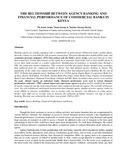| dc.description.abstract | Banking agents are usually equipped with a combination of point-of-sale (POS)card reader, mobile phone, barcode scanner to scan bills for bill payment transactions, Personal Identification Number(PIN) pads, and sometimes personal computers (PCs) that connect with the bank’s server using a personal dial-up or other data connection. Clients that transact at the agent use a magnetic stripe bank card or their mobile phone to access their bank account or e-wallet respectively. Identification of customers is normally done through a PIN, but could also involve biometrics. This research used the descriptive design method using secondary data gathered from the commercial banks in Kenya that had adopted agency banking in Kenya. The population of the study was commercial banks in Kenya that had adopted agency banking. By the end of 2012, 10 banks had adopted agency banking with over 12,054 agents: Equity Bank; Co-operative Bank (Co-op Kwa Jirani); KCB Bank; Post Bank; Family Bank (Pesa Pap); Chase Bank (Chase Popote); Consolidated Bank (Conso Maskani); Diamond Trust Bank; Citibank and NIC Bank. Secondary data sources were used for the study. Annual reports on individual banks’ financial performance were used to extract financial performance indicators. CBK’s annual report and supervisory reports was also used to establish the number of agents registered and the total transactional value conducted through the agents. The variable of interests were: the cash withdrawal and deposit transactions done through agents; number of active agents; return on assets (ROA) to measure profitability; cost to income ratio (to measure cost efficiency in using agency banks); and, staff cost to revenue ratio to measure the reduction of human resource cost due to agency banking. The data was collected for the three-year period: 2010 to 2012. | en |

